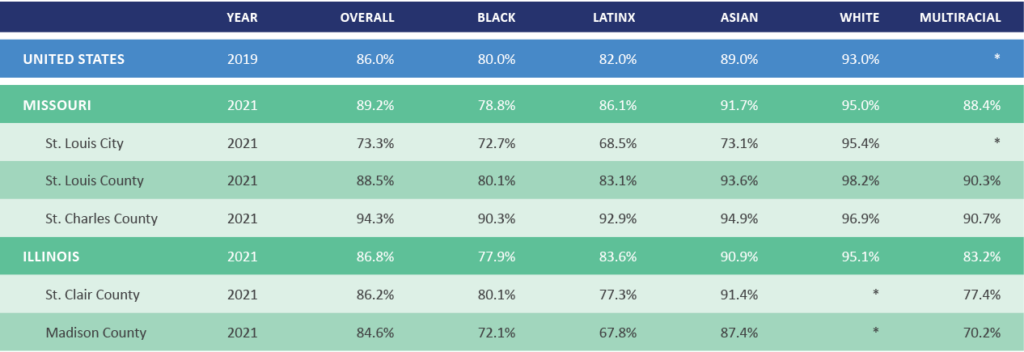Equity Data
Quality Education
Four-Year Graduation Rate
Students who graduate from high school are more likely to experience success in college and career and to become productive, engaged members of society. High school graduates are less likely than high school dropouts to be unemployed, live in poverty, have poor health outcomes, or have children who live in poverty. Graduation rates have been steadily increasing for all students. However, there is still a significant gap between the graduation rates of White students and those of Black and Hispanic students.


US: National Center for Education Statistics (NCES), MO: Missouri Department of Elementary & Secondary Education. Missouri Comprehensive Data System. Accessed at https://apps.dese.mo.gov/MCDS/home.aspx. Data from school year 2021. IL: Illinois State Board of Education. Illinois Report Card. Accessed at https://www.illinoisreportcard.com/. Data from 2021 school year.
Percent Proficient/Advanced in 3rd Grade Reading
During the first three years of K-12 schooling children learn how to read. However, by fourth grade children must use their reading skills to learn and master all other subjects. By this point, if a child is not reading proficiently they are at risk of quickly falling behind in all academic areas. Reading proficiency continues to be alarmingly low among children from low-income families and children of color.

US: National Center for Education Statistics (NCES), MO: Missouri Department of Elementary & Secondary Education. Missouri Comprehensive Data System. Accessed at https://apps.dese.mo.gov/MCDS/home.aspx. Data from school year 2021. IL: Illinois State Board of Education. Illinois Report Card. Accessed at https://www.illinoisreportcard.com/. Data from 2021 school year.
Percent Proficient/Advanced in 8th Grade Math
The level of proficiency students have in mathematics by 8th grade is linked not only to the number of higher-level mathematics and sciences courses students take in high school (and to their success in those courses), but also to numerous additional educational and economic outcomes. Overall, mathematics scores have been rising for students of all races and ethnicities, although White students continue to outscore their Black and Hispanic peers. We must continue to address this achievement gap.

US: National Center for Education Statistics (NCES), MO: Missouri Department of Elementary & Secondary Education. Missouri Comprehensive Data System. Accessed at https://apps.dese.mo.gov/MCDS/home.aspx. Data from school year 2021. IL: Illinois State Board of Education. Illinois Report Card. Accessed at https://www.illinoisreportcard.com/. Data from 2021 school year.
Children’s Data
Vision for Children at Risk informs the community with data and information on child well-being in the St. Louis area, builds and drives collaboration and strategic action for children, and advocates for policies and investment in children that support child well-being.


















